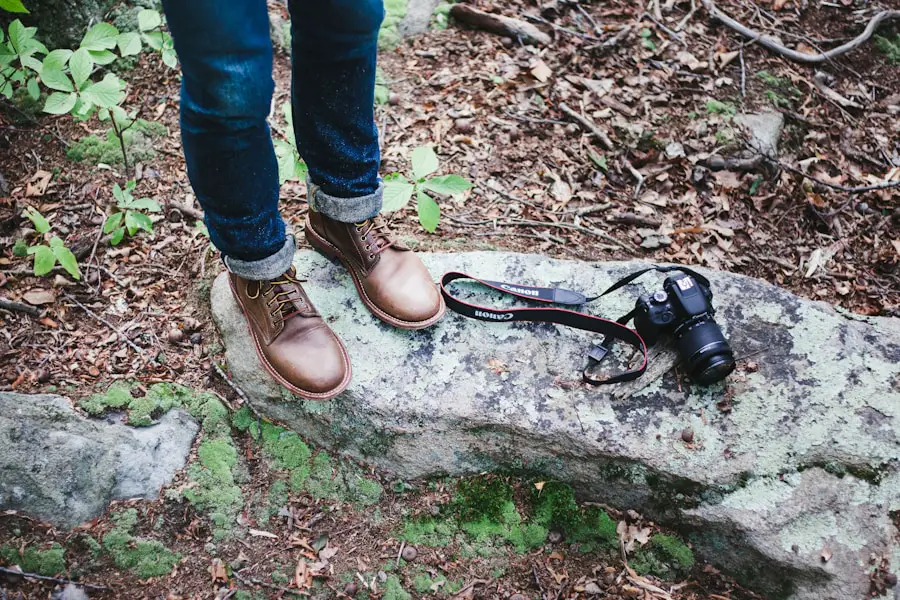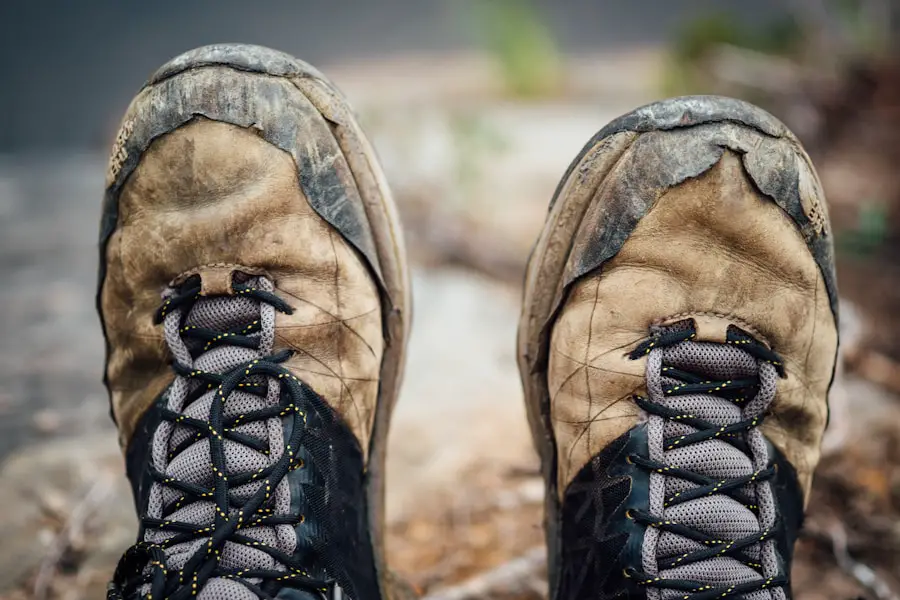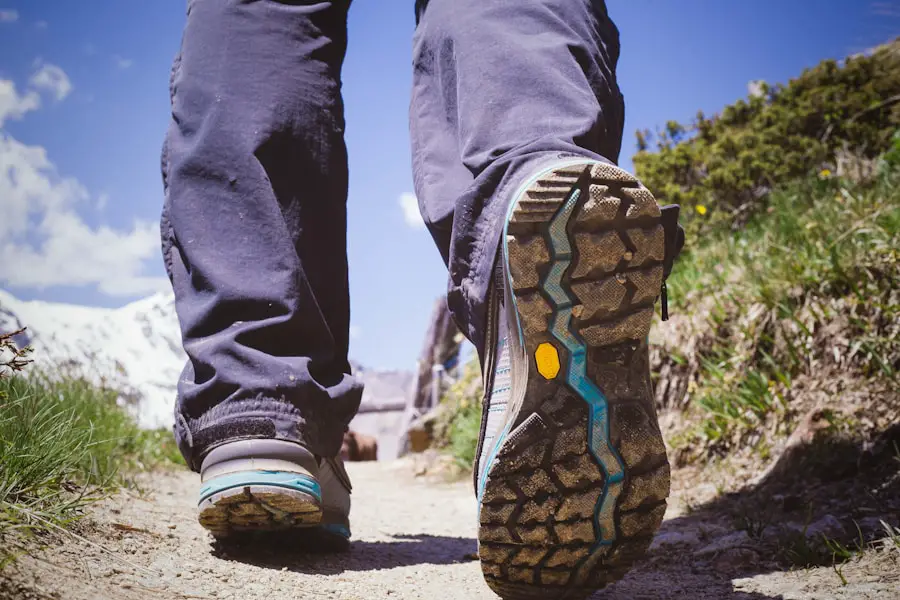When embarking on a hiking adventure, one of the most critical decisions a hiker must make is the choice between hiking shoes and hiking boots. While both types of footwear are designed to provide support and traction on various terrains, they differ significantly in construction, intended use, and overall performance. Hiking shoes are typically lighter and more flexible than their boot counterparts, making them ideal for day hikes or well-maintained trails.
They often resemble athletic shoes, featuring breathable materials and a lower cut that allows for greater freedom of movement around the ankle. In contrast, hiking boots are designed for more rugged conditions and offer enhanced ankle support and protection. They are generally constructed with sturdier materials, such as leather or heavy-duty synthetic fabrics, which provide durability and resistance to abrasions.
The higher cut of hiking boots helps stabilize the ankle, reducing the risk of sprains on uneven terrain. This distinction is crucial for hikers to understand, as the choice between shoes and boots can significantly impact comfort, performance, and safety during outdoor excursions.
Key Takeaways
- Hiking shoes are lighter and more flexible, while hiking boots provide more ankle support and protection.
- Factors to consider when choosing footwear for hiking include terrain, weather conditions, and personal preference.
- Advantages of hiking shoes include breathability, lightweight design, and versatility, while disadvantages include less ankle support and protection.
- Advantages of hiking boots include ankle support, protection, and stability, while disadvantages include heavier weight and less breathability.
- Choose hiking shoes for light trails and warm weather, and hiking boots for rugged terrain and cold, wet conditions.
Factors to Consider When Choosing Footwear for Hiking
Selecting the right footwear for hiking involves several key factors that can influence both comfort and performance on the trail. One of the primary considerations is the type of terrain you will encounter. For instance, if your hike involves rocky paths, steep inclines, or muddy conditions, you may require footwear with a more aggressive tread pattern and additional support.
Conversely, if you plan to stick to well-maintained trails or flat surfaces, a lighter shoe may suffice. Another important factor is the duration of your hike. Longer treks often necessitate more supportive footwear to prevent fatigue and discomfort.
Hiking boots typically provide better cushioning and support for extended wear, while hiking shoes may be more suitable for shorter outings. Additionally, consider the weather conditions you might face. Waterproof materials can be essential in wet environments, while breathable fabrics are preferable in hot climates to prevent overheating and moisture buildup.
Advantages and Disadvantages of Hiking Shoes

Hiking shoes come with a range of advantages that make them appealing to many outdoor enthusiasts. One of the most significant benefits is their lightweight design, which allows for greater agility and speed on the trail. This feature is particularly advantageous for those who prefer fast-paced hikes or need to cover considerable distances quickly.
The flexibility of hiking shoes also contributes to a more natural foot movement, enhancing comfort during long walks. However, hiking shoes do have their drawbacks. While they excel in providing comfort and agility, they may lack the necessary support for challenging terrains.
Hikers venturing into rocky or uneven landscapes might find that shoes do not offer adequate ankle support, increasing the risk of injury. Additionally, their lower cut can expose the ankles to debris and potential scrapes from branches or rocks. In colder weather or wet conditions, hiking shoes may not provide sufficient insulation or waterproofing, leading to discomfort during adverse weather.
Advantages and Disadvantages of Hiking Boots
| Advantages | Disadvantages |
|---|---|
| Provides ankle support | Can be heavy |
| Protects feet from rough terrain | May require break-in period |
| Waterproof options available | Can be expensive |
| Offers stability on uneven surfaces | Not as breathable as trail shoes |
Hiking boots are often favored for their robust construction and superior ankle support. One of their primary advantages is their ability to provide stability on uneven ground, which is crucial for preventing injuries during challenging hikes. The higher cut of boots helps protect the ankles from twists and turns that can occur on rocky trails or during steep descents.
Furthermore, many hiking boots are designed with waterproof materials that keep feet dry in wet conditions, making them suitable for a variety of weather scenarios. On the downside, hiking boots can be heavier and less flexible than shoes, which may lead to fatigue over long distances. The stiffer construction can also restrict natural foot movement, potentially causing discomfort for some hikers.
Additionally, breaking in a new pair of hiking boots can take time; an ill-fitting boot can lead to blisters and sore spots if not properly adjusted to the wearer’s foot shape. This necessity for a break-in period can deter some hikers from choosing boots over lighter alternatives.
Choosing the Right Footwear Based on Terrain and Weather Conditions
The decision between hiking shoes and boots should be heavily influenced by the specific terrain you plan to traverse. For example, if your hike includes rocky paths or steep inclines, a sturdy pair of hiking boots would be more appropriate due to their enhanced support and traction capabilities. The rugged soles of boots are designed to grip uneven surfaces effectively, providing stability that is essential when navigating challenging landscapes.
Weather conditions also play a pivotal role in determining the best footwear choice. In wet or muddy environments, waterproof hiking boots can keep your feet dry and comfortable throughout your journey. Conversely, in hot weather conditions where breathability is paramount, lightweight hiking shoes made from mesh materials can help regulate temperature and wick away moisture.
Understanding how terrain and weather interact with your footwear choice will ensure a more enjoyable hiking experience.
Tips for Trying on and Testing Hiking Shoes and Boots

When it comes to selecting the right hiking footwear, trying on different models is essential to find the perfect fit. Start by wearing the socks you intend to use while hiking; this will give you a more accurate sense of how the shoes or boots will feel during your adventures. Pay attention to the fit around your toes; there should be enough room to wiggle them without feeling cramped.
A good rule of thumb is to have about a thumb’s width of space between your longest toe and the end of the shoe. Additionally, consider walking around in the store or on an inclined surface if possible. This will help you assess how the footwear feels during movement and whether it provides adequate support for your arches and ankles.
It’s also wise to test different lacing techniques; adjusting how tightly you lace your shoes can significantly affect comfort levels. If you’re purchasing online, ensure you check return policies so you can exchange them if they don’t meet your expectations after testing them out on local trails.
Maintenance and Care for Hiking Shoes and Boots
Proper maintenance is crucial for extending the lifespan of your hiking shoes or boots. After each hike, it’s essential to clean off any dirt or mud that has accumulated on the exterior. Use a soft brush or cloth to remove debris from the soles and uppers; this prevents buildup that can degrade materials over time.
For waterproof models, ensure that you reapply waterproofing treatments as needed to maintain their effectiveness against moisture. Storage is another important aspect of care; avoid leaving your footwear in damp areas or direct sunlight for extended periods as this can cause materials to break down prematurely. Instead, store them in a cool, dry place with good ventilation.
If your shoes or boots become wet during a hike, allow them to air dry naturally rather than using heat sources like radiators or hair dryers, which can warp materials and compromise their structure.
Making the Final Decision: Hiking Shoes or Hiking Boots?
Ultimately, deciding between hiking shoes and hiking boots hinges on personal preferences as well as specific hiking needs. If you prioritize speed and agility on well-maintained trails or shorter hikes, lightweight hiking shoes may be your best bet. They offer comfort and flexibility that can enhance your overall experience on less demanding terrain.
Conversely, if you frequently tackle rugged trails or venture into unpredictable weather conditions, investing in a sturdy pair of hiking boots could prove invaluable. Their superior support and protection can make all the difference in ensuring safety and comfort during challenging hikes. By carefully considering factors such as terrain type, weather conditions, personal comfort preferences, and maintenance requirements, you can make an informed decision that aligns with your hiking goals and enhances your outdoor adventures.
If you are planning a hiking trip, it is important to understand the difference between hiking shoes and hiking boots. Hiking shoes are lighter and more flexible, making them ideal for day hikes or trails with minimal elevation gain. On the other hand, hiking boots provide more ankle support and are better suited for rugged terrain or longer backpacking trips. For more information on choosing the right footwear for your hiking adventure, check out this article on the best time to travel to Iceland.
FAQs
What is the difference between hiking shoes and hiking boots?
Hiking shoes are low-cut footwear that provides flexibility and breathability, while hiking boots are higher-cut and offer more ankle support and stability.
When should I choose hiking shoes over hiking boots?
Hiking shoes are ideal for day hikes on well-maintained trails, or for those who prefer a lighter and more flexible option. They are also suitable for warm weather conditions.
When should I choose hiking boots over hiking shoes?
Hiking boots are recommended for longer hikes, backpacking trips, or hikes on rugged and uneven terrain. They provide better ankle support and protection against rough terrain and potential ankle injuries.
What are the key features of hiking shoes?
Hiking shoes typically have a low-cut design, lightweight construction, flexible soles, and breathable materials. They are designed for comfort and agility on less demanding trails.
What are the key features of hiking boots?
Hiking boots are characterized by their higher-cut design, sturdy construction, supportive midsoles, and durable outsoles. They are built to provide stability and protection on challenging terrains.
Can hiking shoes be used for backpacking trips?
Hiking shoes can be used for lightweight backpacking trips on well-maintained trails, but they may not provide the same level of ankle support and protection as hiking boots for more strenuous backpacking trips.
